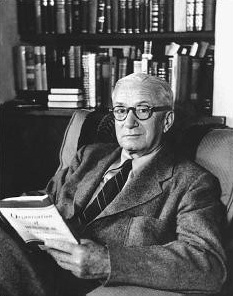<Back to Index>
- Philosopher and Psychologist Edwin Ray Guthrie, 1886
PAGE SPONSOR

Edwin Ray Guthrie (January 9, 1886, Lincoln, Nebraska – April 23, 1959, Seattle, Washington) was a philosopher, mathematician, and later became a behavior psychologist. Guthrie is best known for his one trial theory, non reinforcement, and contiguity learning. One word that could describe Guthrie is “simple." His approach to learning and theories was simple. His simplistic nature was carried into his teachings where he took great pride in working with and teaching students, especially undergraduate students.
Guthrie received a bachelor’s degree in mathematics and a master's degree in philosophy from the University of Nebraska. He got his Ph.D. in philosophy at the University of Pennsylvania (1912). He taught high school math until he was offered a position as a philosophy professor at the University of Washington (1914). One of Guthrie’s influences was his professor in college, Harry Kirke Wolfe, who was one of Wilhelm Wundt’s Ph.D. students. In 1919 Guthrie changed from philosophy to the department of psychology. He later became the dean of the graduate school in 1943 and president of the American Psychological Association (1945).
Guthrie’s
father was a store manager and his mother was a school teacher. Guthrie
was the oldest of five children. At an early age Guthrie showed great
interest in learning. When he was in eighth grade he read Charles Darwin’s The Origin of Species and The Expression of the Emotions. He was married to Helen Macdonald. He traveled with his wife and met Pierre Janet in France. Janet’s writing had a great impact on Guthrie’s thinking. Guthrie and his wife translated Janet’s Principles of Psychology together. Guthrie added to Janet’s writings an objective theory of learning.
Guthrie established his learning theory with Stevenson Smith, who worked with him at the University of Washington. Guthrie’s main principle for his theory of learning was contiguity. He defined contiguity as, “A combination of stimuli which has accompanied a movement on its reoccurrence tend to be followed by that movement”. Guthrie’s one trial learning theory states that in the first instance of a stimulus situation a person makes a complete association. The theory predicts you will respond to the stimulus the same way that worked previously. Guthrie felt the principle of learning was all or nothing in the first trial. The association between the stimulus and response does not change or improve with practice. Guthrie felt perfection was attainable on the first try, practice does not make perfect, it only appears to improve with repetition. Guthrie felt his theory of learning applies in all instances and that there is only one type of learning. The differences seen in learning are not due to different types of learning but due to different situations.
He stressed that movement - produced stimuli is a sensation produced by the movements themselves in maintaining sequential responding. He referred to stimuli and movements as a combination. He believed that there is a difference between movements and acts. A movement is learned and a small part of a behavior, while an act is a bunch of movements that makes up a skill.
Guthrie studied with George P. Horton using puzzle boxes to demonstrate his learning theory. They put cats in the puzzle boxes and observed the cats escape behaviors. A post or tube released the front door of the puzzle box to allow the cats to escape. Their goal of the experiment was to demonstrate one - trial learning. He believed this could be shown by a stereotyping of behavior. When the cat escaped from the box it should be able to remember the last thing it did to be able to perform the escape again. Guthrie and Horton found significant evidence for stereotyping behavior. They reported that in each trial the cats made one association, a trial / escape. This is different from Edward Thorndike’s cat experiment findings. Thorndike believed a learning curve took place with each trial as the association increased between the stimulus and the successful response of the escape.
Guthrie did not feel reinforcement had an effect on learning. He did not think reinforcement is important for a stimulus response association because it occurs after the association had previously been made. Guthrie also believed punishment was effective not by how painful it was but by whether it elicited a behavior that was incompatible with the undesirable behavior. He felt extinction was the result of the process of establishing new responses to old stimuli.
Guthrie felt the best way to break a habit is to create a new behavior to replace the old one. Habits do not go away or fade with disuse or lack of practice. Guthrie’s method for breaking habits is considered an interference theory which is when forgetting occurs because new learning interferes with previous learning, or vice versa. Guthrie’s theory for breaking habits is still used in many modern day therapies.